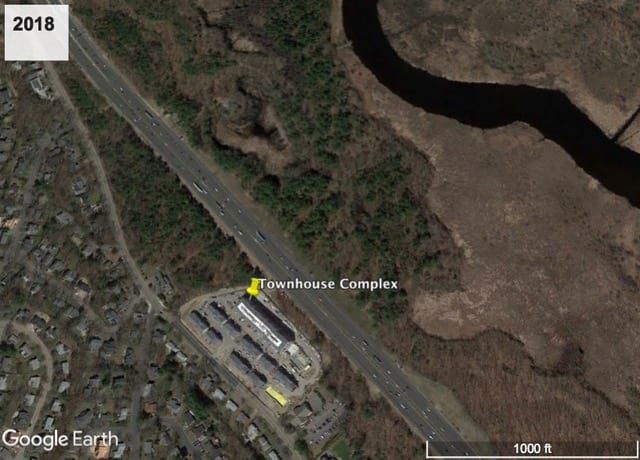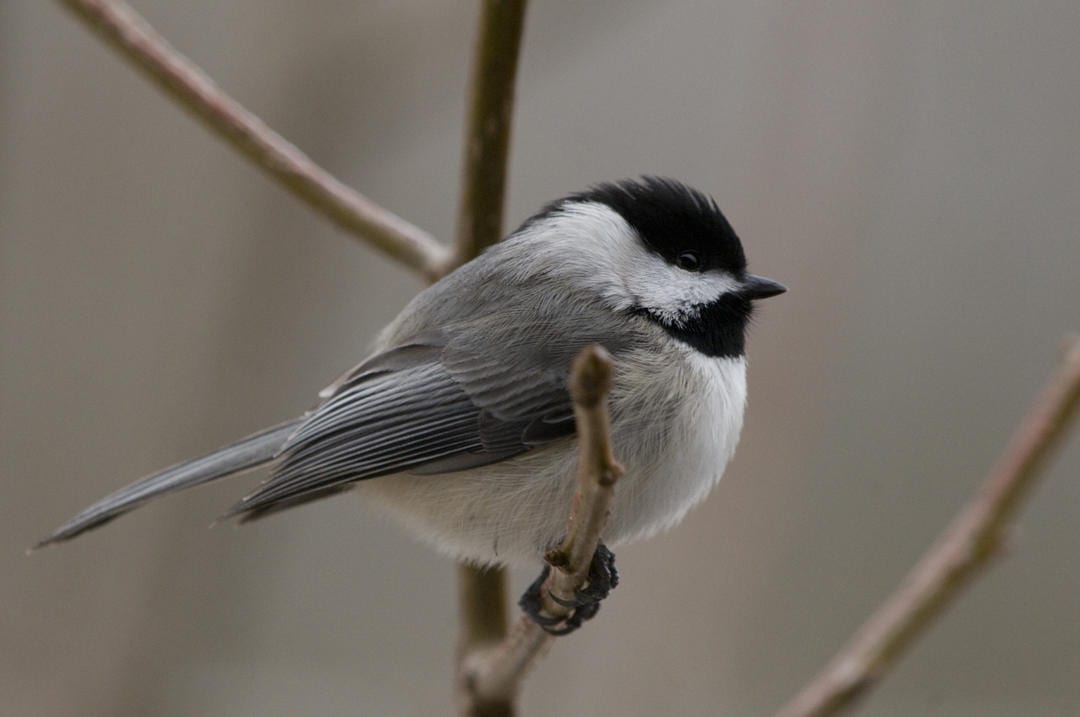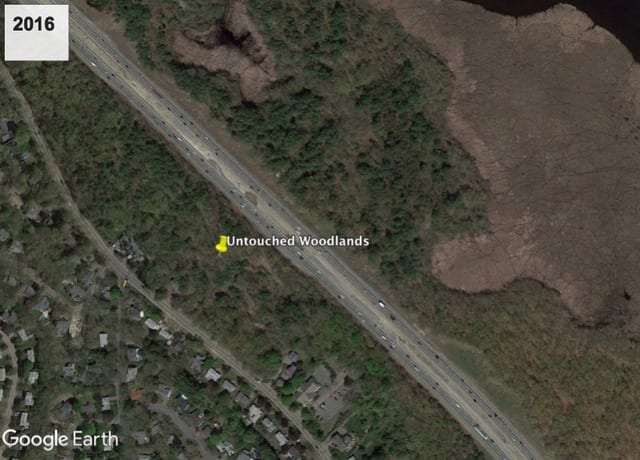by Marie Chieppo
I looked out the window this morning and with great pleasure watched the wide variety of birds at my feeders. The speed at which they landed and took off reminded me of an airplane runway. My eyes followed to where they perched to consume their meals – the oldest and largest tree on my property. I then scanned the surrounding properties to find similar-sized trees, but sadly, they were few and far between.
In a single day, houses are demolished in my town and trees are ground up. Typically, what’s left is a graveyard of large tree roots and dirt. There are no signs of wildlife; the lots are decimated. Not surprisingly, as urban housing prices increase so does the suburban sprawl. In many metropolitan locations the demand for large new homes is at an all-time high. When single lots are not available, acres of land may be deforested to make room for condominiums and townhouses.

Two years later, six acres of mature trees has been deforested for a development complex composed of townhouses and condominiums.
The recent UN’s Sustainable Development Goals clearly states the need for “rapid, far-reaching and unprecedented changes in all aspects of society.” One of the goals is a halt to land degradation and loss of biodiversity. In October’s ELA Newsletter, Laurence Wiseman [Urban Trees: A Pathway to Meeting Forest Sustainability Goals and a Vehicle to Get You There] refers to the decline in our urban trees. He reports, “The Forest Service estimates that cities lost approximately 36 million trees annually between 2009 and 2014.” This results in hotter urban atmospheric temperatures, loss of habitat, soil erosion and death of established ecosystems, to name a few. Wiseman also makes reference to the US Forest Service’s Vibrant Cities Lab, an online resource documenting the benefits of urban trees and effective urban forest initiatives for increased sustainability. Initiatives like this are a valuable resource for those involved in urban planning and planting alike. Thanks to multiple studies and media coverage of the mental and physical benefits to humans, the public is demanding more green space in the cities. Hopefully what will follow is less demolition and allowance for mature trees to remain undisturbed.
Because most suburban areas are composed of private properties, comprehensive tree data is typically more challenging to acquire. Some towns have strict ordinances about selective tree removal and compilation of data, but they are in the minority. The lack of data makes it difficult for such trends to receive much attention. Forestry personnel are at their wits end. Typically their input regarding the removal of healthy trees on a lot doesn’t have much impact. When the plan’s footprint is larger than the former’s, the tree(s) are taken out.
When mature trees and other vegetation are removed property owners and neighbors generally have little awareness of the negative impact on the ecosystem. Invisible to the naked eye, the vast water transport systems, and the structure, fertility and stability of the soil are all compromised. Micro-organisms and other soil inhabitants decline as does the bio-diversity of plant and animal life. Trees are significant air and ground coolants and insulators from the impact of frigid winds. They also sequester significant amounts of carbon dioxide and filter particulates by trapping them on their leaves and bark.
At this juncture, landscape designers need to step up and advocate for more incorporation of mature trees. To do this, they need to be at the planning table from the very beginning. Ecological designers are experts in the incorporation of mature native and non-native trees and plants; how to address erosion issues through the use of ground covers, rain gardens and dry rivers; and use of typical lawn grass alternatives to reduce the need for irrigation and synthetic fertilizers. The end result is a beautiful healthy landscape. Short of that, designers have an obligation to create a landscape that will provide as much benefit overall to the ecosystem.
Through education about what’s involved in having a healthy landscape and how it mitigates climate change, we can hope to get homeowners, builders and architects to think more seriously about the ecological impact of development before completely stripping all plants from a property.

A designer’s priority should be the establishment of a healthy garden community. Nature then does most of the work.
Sadly, deforestation and depletion of long-standing ecosystems are on the rise. Responsible re-creation of green space both public and private needs to follow. New research is showing when comparing a variety of natural climate solutions to mitigate global warming, reforestation was proven to have the greatest carbon storage potential. The report finds that “…increased reforestation efforts had the largest carbon storage potential, equivalent to keeping 65 million passenger cars off the road.”(1) By removing thousands of trees now, we’re countering everything common sense and science are telling us: whenever possible leave trees in place. It will take years to regenerate a single tree’s full carbon storage potential.
 The plethora of wildlife in my backyard rely on the large tree every day for food, shelter and a place to perch and eat their meals. There is other life, some naked to the human eye, that also relies on it. And in turn, it relies on them. This is a healthy ecosystem.
The plethora of wildlife in my backyard rely on the large tree every day for food, shelter and a place to perch and eat their meals. There is other life, some naked to the human eye, that also relies on it. And in turn, it relies on them. This is a healthy ecosystem.
Citation
- Fargione, J. E., Bassett, S., Boucher, T., Bridgham, S. D., Conant, R. T., Cook-Patton, S. C., … & Gu, H. (2018). Natural climate solutions for the United States. Science Advances, 4(11), eaat1869. doi:10.1126/sciadv.aat1869
About the Author
Marie Chieppo is a Certified Massachusetts Master Gardener and Certified Native Plant Designer and Horticulturist. She is Principal at EcoPlantPlans, LLC where she has been creating beautiful and healthy landscapes for close to 20 years.
***
Each author appearing herein retains original copyright. Right to reproduce or disseminate all material herein, including to Columbia University Library’s CAUSEWAY Project, is otherwise reserved by ELA. Please contact ELA for permission to reprint.
Mention of products is not intended to constitute endorsement. Opinions expressed in this newsletter article do not necessarily represent those of ELA’s directors, staff, or members.



